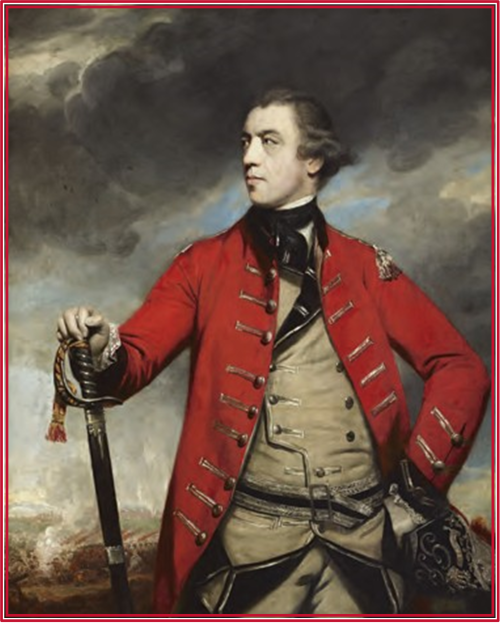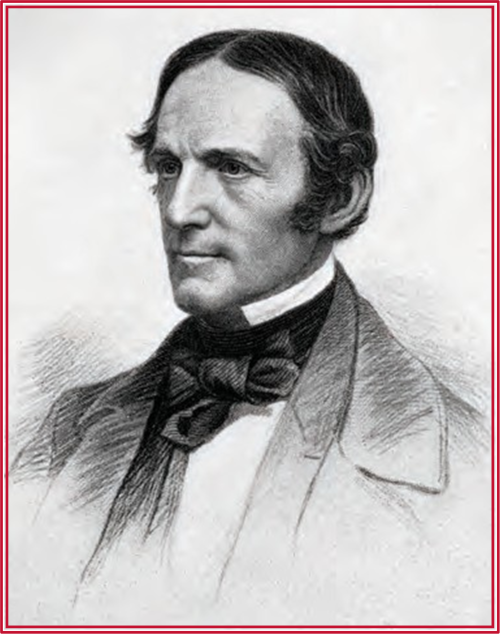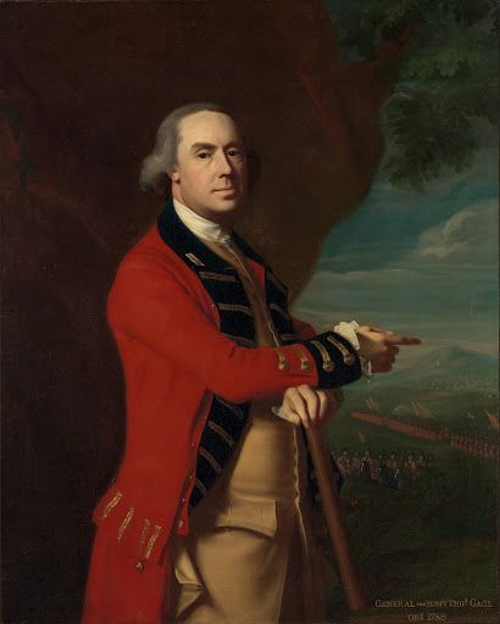Four Men From Middlesex
By George T. Loker Jr., West Michigan Chapter
SAR Magazine
Spring 2020, Vol. 114, No. 4
Members of the Loker family who represented my line of descent left the tiny village of Bures, Essex, England, in 1638, bound for the Massachusetts Bay Colony.
Their goal was to join a group of likeminded Puritans as founders of the town of Sudbury, a frontier town 20 miles west of Boston and eight miles south of Concord in Middlesex County. They were successful in their venture; over the years, many Loker households populated Sudbury and the surrounding towns that came into existence. The people of Middlesex County set about acquiring land, building homes, working hard and enjoying a life they might otherwise have never known.
By the time the landmark year of 1775 arrived, all of that effort was in danger of being undone. King George III had brought the political negotiations with the Massachusetts Bay Colony to a halt, demanded that all civil disobedience in the colony cease and threatened to nullify the Massachusetts charter, thereby stripping the Colonists of legal ownership of their land and their homes. He went on to label the Colonists as rebels and put a price on the heads of Samuel Adams and John Hancock. All of this was to be enforced by Gen. Thomas Gage, commander of British forces in North America, and the 4,000 regular army troops stationed in Boston.




Surrender following the Battle of Saratoga; top, Gen. Horatio Gates; second, Gen. John Burgoyne; third, Col. William Prescott; last, Gen. Thomas Gage.
To the Colonists, the world must have seemed upside down. One hundred and forty years of success was labeled a failure. Their homes and fortunes could be seized. All that they had worked for would come crashing down.
The militia, usually a source of support to the British Army, was now the army of Colonial resistance. The 6th Massachusetts Regiment contained four Loker brothers. Henry Loker, 51, my direct ancestor, was lieutenant/sargent of a company of Minutemen in the nearby town of Natick. Isaac Loker, 36, was captain of the Sudbury Troop of Horse; Jonas Loker, 45, was a surgeon; and John Loker, 56, was a private. Col. John Nixon of Sudbury was the commander.
The tension was growing. All of the militia units had been training throughout the winter, often in barns. Isaac Loker drilled his cavalry unit on the five acres behind his house. The Committee of Safety was warning that the British Regulars might seize arms and gunpowder from militia armories. The Minutemen kept their muskets and rucksacks packed with food next to the front door in preparation for “the call.”
Then it came … at 4 a.m. on April 19. The hoof beats of a galloping horse and the shouts of its rider awakened anyone who hadn’t spent another sleepless night. “Up, up, the Regulars are out!” It was Abel Prescott Jr. of the prominent Prescott family of Concord. His lathered horse was evidence of the condition of the eight miles of country roads he had traveled. Abel quickly made the militia leaders aware of the events that had taken place in Lexington and the certainty that the British troops were on their way to Concord. In what seemed like only seconds, horse and rider were on their way to Framingham.
The clanging of the meetinghouse bell and the firing of a musket was the signal for the militiamen to assemble and form up, which they did amidst the shouts and crying of loved ones. By daybreak, they were on the road to Concord. The band of brothers included fathers and sons, uncles and nephews, cousins, and boyhood friends. At the front of the column was Deacon Josiah Haynes, an 80-year-old volunteer.
They moved with a sense of urgency that came from two carefully guarded secrets. They knew that the British Regulars would search the farm of Col. James Barrett, commander of the Concord militia, for weapons and gunpowder. The muskets had been plowed into Barrett’s fields to avoid detection. The powder, however, was stored in the attic of the Sudbury meetinghouse. If the British had learned of it, they might have been at that moment on a collision course with the Patriots marching north. The existence of Sudbury would be at risk.
As they neared the South Bridge over the Concord River, they met the son of Col. Barrett, who told them the British had mounted artillery on the bridge, so the safe route would be over the North Bridge. Abel Prescott Jr. had been the first to encounter the British on the South Bridge as he returned from spreading the alarm. Although he escaped, he suffered an upper-body wound from a musket ball that eventually took his life, a little-known Patriot of a nation yet unborn.
The column reached the North Bridge at about 9 a.m. and joined other Minuteman groups that were entering the Concord Patriots on Punkatasset Hill. The deadly encounter between British and Patriot forces at the North Bridge took place soon after and ushered in the happenings of the rest of the day. With first blood spilled, the British commander, Col. Francis Smith, called in his pickets, tended to the wounded and began the retreat toward Lexington around noon.
The Colonists followed at double time, those who knew the lanes and cow paths that paralleled the road leading others to firing positions behind trees and stonewalls ahead of the British. Some Minutemen units were already in place and sniping at the main body of the column. The Regulars took particular punishment at places like Merriam’s Corner and Hardy’s Hill, where the terrain and sightlines favored the Colonists. So on and on it went for miles, the British Regulars putting up the defensive fire while the Colonists chose their targets from cover. It was a new type of warfare in the making.
A three-regiment relief column of 1,000 British Regulars, led by Col. Hugh Percy, intercepted Col. Smith’s tattered troops. They escorted them back through Charlestown, where they collapsed on Bunker Hill while waiting to be ferried across the Charles River to their barracks near Boston’s Long Wharf.
The British had suffered 73 killed and 174 wounded; the Americans, 49 dead and 39 wounded. Among those Patriots killed was Deacon Haynes.
The toll had been significant for both sides, and the British contempt for the American militia had taken a severe blow. The Patriot forces, swelled by the arrival of militia companies from northern towns, marched into Cambridge and occupied Harvard College and homes abandoned by Loyalist families. The Patriot troops quickly built huts from available materials that would protect them from the weather.
The siege of Boston had begun.
In the dark morning hours of June 17, 1775, Henry Loker and all the members of the regiment were doing what farmers do best: moving dirt. Word had come that on June 18, the British planned to seize control of Bunker Hill, one of the two most valuable artillery sites overlooking Boston. Col. William Prescott, a battle-tested veteran of the French and Indian War, had been given an impossible mission—to fortify the hill in the dark of night and before the break of dawn. A thousand men set to the task, and when the British troops awoke, they were amazed to see the rebels entrenched in a crude but serviceable fortification. Henry Loker likely was not amazed. He knew what Prescott could do. They were cousins.
The British commanders lost no time in forming up their units and transporting them across the Charles River in barges. The enthralled population of Boston took to rooftops and other sites to witness the conflict. Artists set up their easels and captured the scenes of the battle as it unfolded.
The Patriots, crouched in their trenches, braced for the first charge. Nixon’s unit occupied one of the weaker positions; some of the gaps were filled only with bales of hay. Henry and his company had front-row seats for what was to come. British warships had already begun covering cannon fire on the enemy; Charlestown would soon be burning.
The British were unprepared for and overwhelmed by the ferocity of firepower that came from the American line. Two lines of Britain’s finest melted into the tall grass. Even the most vulnerable parts of the Patriot line repulsed the attack.
The second charge met the same level of resistance, with one exception. To save ammunition, Col. Prescott ordered his men to hold fire until the attackers came within 30 yards. Col. John Nixon was seriously wounded and was carried from the field but would recover to lead a long and full life. His regiment would be among the last to leave the battlefield.
The third charge drained the strength of both sides to the level of exhaustion. The struggle teetered between the two foes until the Patriots ran out of ammunition, and hand-to- hand combat ensued. Col. Prescott could see that staying in the fortress meant certain death, and he ordered a retreat.
The losses on both sides were significant. Of the British, 226 were killed and 828 wounded, for a total of 1,054, or about 50 percent, of the 2,300 combatants. The Americans suffered 138 killed, 38 missing or captured, and 276 wounded, totaling 450.
Although the British claimed a victory, a member of parliament observed to Prime Minister Lord Frederick North that if there were many more victories of this sort, there would be no one left to report them.
Among those Patriots lost was Jonas Loker, surgeon, who was killed by British cannon fire as he tended to the wounded. Jonas and all the others are honored by plaques bearing their names, units and homes on the Bunker Hill Memorial, which is guarded by a life-sized statue of William Prescott.
In the early fall of 1777, Henry Loker and the rest of the 6th Massachusetts marched the 200 miles between Sudbury and Saratoga, N.Y., to address the threat of an invasion originating in Canada.
Gen. John Burgoyne convinced King George III of a plan to divide and neutralize the northern Colonies. By sending an army consisting of British troops and Prussian mercenaries from Canada south to Lake Champlain, he would capture Fort Ticonderoga and continue south to seize Albany, giving the British control of the Hudson River and the territory east and west of the Hudson.
Burgoyne assembled an army of 4,400 British and 4,700 Prussian troops at a staging area near Montreal and outlined in a fleet of boats across Lake Champlain in June 1777. The fort fell into his hands according to plan. At this point, Burgoyne abandoned his ships and began working his way down the eastern shore of Lake George. Progress was exceedingly slow thanks to the resistance of American forces and the unforgiving wilderness.
The trek began on July 6, but it wasn’t until Sept. 13 that Burgoyne set eyes on the American emplacements on the western shore of the Hudson, at a place called Bemis Heights. The journey had cost him more than 1,000 men, the Loyalists he had expected to recruit along the way were few, and the food supply was dwindling.
In the meantime, Gen. Horatio Gates of the Continental Army was keeping track of Burgoyne’s progress and assembled an army of 9,000 men to greet him. The Colonists arrived at Bemis Heights on Sept. 8 and immediately set to work by adding fortifications to the natural advantages of the site. Working in shifts, they continued through Oct. 6. Henry Loker might have had to move more dirt, but this time he could do it in daylight.
The first clash between these two armies, called the Battle of Freeman’s Farm, took place on Sept. 19. It raged throughout the day, but in the end, they blocked the British forces’ path to Albany. Burgoyne chose to pause for 17 days while he waited for news of support from Gen. William Howe that never came.
With food supplies dangerously low and desertions increasing, Burgoyne made a final attempt on Oct. 7 to break through the American line, but without success. Nevertheless, he prolonged the negotiations for terms of surrender for nine more days, in the hopes that Howe would appear and save the day.
On Oct. 16, 1777, Henry and the rest of the 6th Massachusetts stood at ease while the British soldiers surrendered their arms. More than 6,000 British and Prussian troops were captured, 440 killed and 695 wounded. The Colonists reported 90 dead and 240 injured.
John Trumbull’s portrait of the surrender of Burgoyne that hangs in the rotunda of the U.S. Capitol has all the earmarks of a recruitment poster. It shows William Prescott, wearing a plain brown suit, standing next to Daniel Morgan, commander of Morgan’s Regiment of Riflemen.
Some sources suggest that Col. Prescott came out of retirement as a volunteer with one of the Massachusetts regiments. No doubt, he had the status of a folk hero to militiamen and bolstered their morale and courage. Morgan’s Riflemen had proven their worth by turning the tide of battle more than once. Here they were, two heroes of an American campaign that had little to celebrate so far. Daniel Morgan dominates the center of the portrait. While all the other subjects have their eyes on the surrender ceremony, Morgan is looking out at the viewer with a facial expression that says, “You could be in this picture,” to all the young men of the Colonies.
The outcome of the Battle of Saratoga convinced George III to draw down on military action in the northern Colonies and to begin a campaign in the South. That decision resulted in a series of defeats for England that would lead to Yorktown.
For Henry Loker and his brothers and friends, it meant that they could take the road home.
References
- Oliver N. Bacon. A History of Natick
- Esther Forbes. Paul Revere and the World He Lived In David Hackett Fischer. Paul Revere’s Ride
- Alfred S. Hudson. The History of Sudbury, Massachusetts, 1638-1889
- Richard M. Ketchum. Decisive Day: The Battle for Bunker Hill
- A.J. Langguth. Patriots: The Men Who Started the American Revolution
- John F. Luzader. Saratoga
- Daughters of the American Revolution Archives
